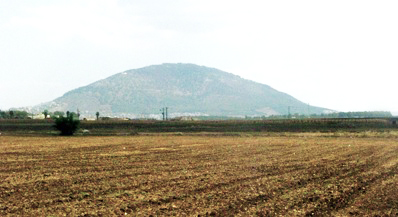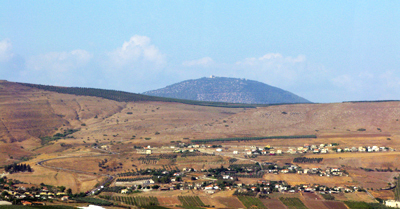

Mt Tabor, viewed from the Jezreel Valley.
This mountain, distinctive in its profile is situated at the north end of the Jezreel Valley. Its peak, at 588m, provides a panorama of the land for miles around. It was, perhaps, for this reason that Deborah commanded Barak to array the "ten thousand men of Naphtali and Zebulun" there for the battle against Jabin and Sisera (Judg 4). Sisera's 900 chariots advancing on the mountain would have been visible to Deborah and the Israelite troops. And when the sudden rain turned the field below into bogging mud, the Israelite army was able to sweep down mercilessly upon them.
Since Deborah, other armies have suffered similar fate at the mountain. But Tabor is also seen as symbolic of strength, as when Jeremiah compared it (and Mount Carmel) to the might of Nebuchadnezzar (Jer 48:18). For possibly idolatrous practices on the mountain by the northern state, Hosea likened Tabor to "a snare . . . a net spread out on Tabor" (5:1).

Mt Tabor, as seen from Upper Galilee
The mountain is often thought of also as the Mount of Transfiguration, though the tradition can firmly be traced back only to 348 in the decision of Cyril of Jerusalem. The New Testament provides no definitive information for identifying Tabor with the transfiguration (Matt 17:1ff; Mk 9:2ff; Lk 9:28ff).
The summit is occupied by two monasteries, one Roman Catholic and the other Greek Orthodox. More interesting is the majestic view it offers of the surrounding; an ideal place to understand the comings and goings of ancient Israelite history in this part of their country.
Tabor is mentioned 12x in the OT. All except possibly 1 Sam 10:3 refer to Mount Tabor in Galilee; the identity of "the great tree of Tabor" here remains uncertain.

©ALBERITH
050916lch